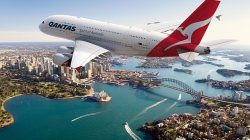A little over 2 months ago, it was rumored that a new carrier would be operating an Airbus A380 into Dallas/Ft. Worth International airport when the board approved a nearly $3 million construction plan at International Terminal D to accommodate the wide-body plane at gates D15 and D16.
My initial projections were that the two likeliest contenders for bringing the A380 to DFW were Qantas and Emirates. I placed my bets on Qantas over Emirates simply given the fact that Qantas’ international network is smaller than Emirates’ and that they have fewer Airbus A380s to go around. Emirates has 140 Airbus A380s on order, in addition to 44 already in operation. Qantas has 12 in operation with 8 on order.
Another data point to support my initial hunch was that Qantas is re-timing one of its Falcon (formerly known as ‘Kangaroo’) routes operating Melbourne – Dubai – London Heathrow to free up an Airbus A380 frame. However, after evaluating the possible Qantas stations to receive the A380, it became clear that Dallas/Ft. Worth was a strong contender of the remaining options. As I wrote previously,
The beleaguered national airline of Australia has cut so much of its international network over the years that long-haul route cancellations have become the norm rather than the contrary.
What is fascinating is that while the carrier serves a total of 76 nonstop destinations, of these, 55 are domestic, leaving only 21 markets served outside of Australia. Thirteen of these stations fall within the Asia – Pacific region, which leaves a mere 8 destinations served in other parts of the world: Four in North America (Los Angeles, New York JFK, Dallas/Ft. Worth and Honolulu), and one each in Europe (London), Latin America (Santiago), the Middle East (Dubai) and Africa (Johannesburg).
As is, Qantas deploys the A380 to three of these eight markets: Dubai, London Heathrow and Los Angeles. Services to Johannesburg are offered 7 weekly on a Boeing 747, Santiago is 3 weekly on a 747, and Honolulu is thrice weekly on a 767. Both New York JFK and Dallas/Ft. Worth are each served daily on a 747. However, New York is connected to Los Angeles, which flies onward to Sydney. Dallas/Ft. Worth operates in a triangular DFW – Brisbane – Sydney – DFW fashion.
RELATED POST: Emirates, Qantas are likeliest A380 candidates for DFW airport
My conclusion was that of the remaining options (Santiago, New York, Honolulu, Johannesburg and Dallas/Ft. Worth) the likeliest winner would be DFW given that it is the largest OneWorld hub without Qantas A380 services, and is currently served daily on a 747-400. Through process of elimination, Johannesburg (Star hub), Santiago and Honolulu (each served 3-weekly), and New York (out of range) are unviable options for the A380.
What ultimately transpired is that Emirates was the first carrier to announce scheduled A380 service into DFW, and I was incorrect per my initial speculation.
However, it turns out that I was correct after all. Not only will both Qantas and Emirates become A380 operators into DFW, confirming my #1 and #2 suspicions, Qantas will actually beat Emirates to the punch by launching A380 services between Dallas/Ft. Worth and Sydney starting on September 29, two days prior to the launch of Emirates’ scheduled services between Dallas/Ft. Worth and Dubai.
A380 services to Dallas/Ft. Worth will involve schedule and capacity adjustments
The current Qantas service to Dallas/Ft. Worth is served by a Boeing 747-400ER, operating on a daily basis in a triangular routing. Qantas flight 007 originates in Sydney, departing in the early afternoon with a same-day arrival into DFW airport at around the same local time in Dallas. The flight is blocked at 15 hours and 25 minutes operating nonstop in the eastbound direction.
On the return, Qantas flight 008 departs Dallas/Ft. Worth leaving prior to 10PM local time and arriving into Brisbane, Australia 2 days later at 5 AM. The technical stop in Brisbane has existed since Qantas opened its DFW station in May 2011, as the 747 does not have the range to operate nonstop to Sydney in the westbound direction due to headwinds. QF 008 departs Brisbane after a 90 minute hold and returns to Sydney by 8 AM that morning.
The Brisbane stopover on QF 008, while adding an extra layover for passengers originating or terminating their journeys in Sydney, did not create additional inconvenience for connecting passengers onward to domestic destinations within Australia. Rather than flow those passengers to Sydney and create double-connect itineraries, Qantas, who commands roughly 38.5% of the market share from BNE, could funnel passengers from an early morning departure bank to a slew of local markets across the continent. Although technically Brisbane serves as the primary hub base airport for Qantas’ domestic rival carrier, Virgin Australia, data in CAPA airport movements show that Qantas offers early morning connections from BNE to Rockhampton, Townsville, Melbourne, Mackay, Cairns, Perth, Adelaide, Gladstone and Canberra, among other cities, which easily satisfy the top ten domestic O&D markets from Brisbane.
With the removal of the Boeing 747-400ER on the route in favor of the Airbus A380, Qantas will be eliminating the Brisbane stoppover and operate nonstop between Sydney and Dallas/Ft. Worth bi-directionally. Though Qantas will reduce frequency from 7 to 6 weekly flights, thereby eliminating a nonstop service on Tuesdays, overall capacity will still rise by 10% as the Airbus A380 offers 134 additional seats (484 total) than the Boeing 747-400 (350).
Moreover, while Qantas’ level of operations Sydney hub is not substantially larger than those at Brisbane, the reach is slightly broader to help facilitate more connections and itineraries with minimized travel time. It also is critical from an aircraft maintenance perspective as Qantas does not base any of its Airbus A380 widebody frames at Brisbane.
Qantas’ decision prompted by practicality, but prestige will also follow as a corollary
In its official Press Release announcing the A380 services to Dallas/Ft. Worth, Qantas briefly touched upon the fact that its Sydney to Dallas/Ft. Worth route, which is currently the world’s longest route by distance at 7,454 nautical miles, will also be the world’s longest Airbus A380 route. Qantas also mentioned that this will be the first time that a First Class cabin will be available on this route.
However, it was transparent from the Press Release that Qantas’ decision to up-gauge the DFW route to an Airbus A380 was primarily prompted by its transformation program, as the carrier made several references to its fleet and network readjustment program to save up to $600 million over the course of three years for the Qantas Group, in context of a larger $2 billion cost reduction initiative. Qantas International reported a 262 million AUD loss for the 1st half of the 2014 Fiscal Year, a 2.5X increase over the prior operating period.
Along these lines, Qantas announced that the re-timing of its Melbourne – Dubai – London route would help increase connections by four-fold, from a current level of 4 round-trip markets in Europe to 17, enabling nonstop services to Athens, Copenhagen, Dusseldorf, Frankfurt, Geneva, Paris, Hamburg, Milan, Moscow, Munich, Nice, Prague, Rome, Saint Petersburg, Venice, Vienna and Zurich.
As I previously wrote,
Qantas announced yesterday that it intends to re-time its QF 009/010 flights that currently operate Melbourne – Dubai – London Heathrow. Currently, QF 9 leaves MEL at 16:15 in the afternoon with a 23:25 arrival into DXB, then leaves DXB at 1:20 AM with a 5:10 arrival into LHR the next morning. The plane proceeds to sit at Heathrow for over 18 hours before QF 10 leaves LHR at 22:15 with a 9:10 (+1) arrival into DXB the following morning, then with a 10:55 AM departure from DXB and arrival at 7:35 AM the next day into MEL.
Per the press release, Qantas’ new schedule for QF 009/010 will entail a 22:55 late night departure from Melbourne with a 0705 AM next day arrival into Dubai, then continuing service to London would arrive at 1340. Return services would depart London at 1330, arriving into Dubai at 2325 and landing at Melbourne at 2055 the following day. These new times are effective July 20, 2014.
This underscores the increased reliance on Emirates’ European network out of Dubai as part of the Qantas-Emirates partnership. With an early morning arrival into Dubai and a late-night departure on the return, Emirates can facilitate more connections to continental Europe from Melbourne within four hours of arriving into and departing from Dubai. The previous reliance on OneWorld and British Airways connections over London Heathrow, which involves significant backtracking, increased travel time and less-than-palatable terminal switches at Heathrow, had created challenges for Qantas to capture Europe – Australia traffic.
How much will Qantas gain (or lose) at its DFW station with the switch?
The emphasis on the re-timing of the London – Dubai – Melbourne operation poses the question as to whether the DFW upgauge was purely a fortuitous benefactor of the re-timing or an isolated, independent event. Truth be told, Qantas’ DFW station was successful enough to grow from a 3-weekly service to a daily service within a single calendar year, but it remains to be confirmed whether the route is a major money generator.
With OneWorld connections on both ends, along with the ease of connections over DFW versus Qantas’ other US stations (namely LAX), the likelihood of its “success” in terms of high load factors and popularity among lucrative corporate accounts is very high. However, at the end of the day, it is an ultra-long haul flight. At current fuel price levels, the reality is that long-haul flights struggle to generate profits given their massive cost per available seat mile. The 747-400 had to take significant payload hits operating westbound from DFW to Brisbane, and the Airbus A380 will similarly face some restrictions traveling an extra 239 nautical miles from DFW to Sydney. The existing services from DFW to Brisbane have already faced a few teeting pains (although incidences have been minimal) with a few technical diversions to Auckland and Noumea in the South Pacific.
As such, it could be possible that Qantas is banking on the attractiveness of a nonstop flight, increased seating capacity, and the enhanced product offering by introducing First Class on this route, to off-set the risk of placing an A380 on the route.
But how much actual “risk” is at play here? Truth be told, Qantas has focused on Asia and Europe the most in terms of its international network restructuring. The approach to its Americas operations has centered more around substitutions rather than withdrawal. In 2011, Dallas/Ft. Worth replaced San Francisco in the Northern Hemisphere and during the following year, Santiago replaced Buenos Aires. Both moves, considered highly political, were designed around connecting Qantas to international OneWorld hubs, with American at DFW and LAN at Santiago.
As such, at least in the near-term, Qantas maintain a steady hold on its transpacific operations while turning its attention on Asia and Europe. The entrance of the Gulf Coast carriers have eaten it alive between Europe and Australia, and there is some speculation that is partnership with Emirates may be hurting, rather than helping, its Australia – Asia operations. Qantas code-shares on Emirates’ fifth-freedom services from Dubai to Australia which route via Bangkok, Kuala Lumpur and Singapore. With full reciprococity from a loyalty and benefits perspective, Emirates may be attracting Qantas frequent fliers on said routes with lower airfares.
Still, Qantas is putting stock into its Emirates partnership, otherwise, it’s a matter of evolve or die. Fortunately, the transpacific market faces fewer risks without a cost-efficient competitor like the Gulf Coast airlines, offering Qantas greater freedom to shift around capacity. If implemented wisely, the domino effect of allowing the Melbourne – London re-timing to benefit the Sydney – Dallas flight may be one of the first few wise moves made by Qantas’ management in a long time to bring its network back to break-even levels, and hopefully, profitability.


